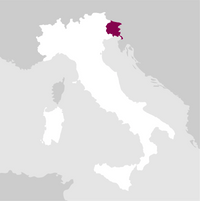Description
Vespa Bianco was created to emphasise the power and balance that a great Friulian white can achieve, with uncommon complexity and longevity.
Awards
Details

Perfume

Color

Taste
Serve at:
12 - 14 °C.
Longevity:
05 - 10 years

Pairings
- Start up year: 1997
- Oenologist: Emilio del Medico
- Bottles produced: 220.000
- Hectares: 27


| Name | Bastianich Vespa Bianco 2021 |
|---|---|
| Type | White still |
| Denomination | Venezia Giulia IGT |
| Vintage | 2021 |
| Size | 0,75 l |
| Alcohol content | 13.5% by volume |
| Grape varieties | 45% Chardonnay, 45% Sauvignon, 10% Picolit |
| Country | Italy |
| Region | Friuli-Venezia Giulia |
| Vendor | Bastianich |
| Story | The flagship of Bastianich company, the Vespa Bianco, was created to highlight the power and evolution a great Friulian white can achieve. The Vespa manages to transcend the sum of its parts, confirming a wine of outstanding complexity and longevity. |
| Origin | Hills of Premariacco and Cividale (Udine). |
| Climate | Altitude: 130 60 m a.s.l. Exposure: South, South-East, South-West. |
| Soil composition | Eocene marl, limestone-based. |
| Plants per hectare | 4,000-8,000 |
| Yield per hectare | 6,000-7,000 kg/hectare |
| Harvest | Depending on the variety, from the first decade of September to the second decade of October. |
| Wine making | Each grape variety is harvested separately when it has reached optimum ripeness. The grapes are sorted on sorting benches before gently pressing, resulting in a first must and press must. Subsequently, the two batches of must are blended to start alcoholic fermentation. The varieties that make up Vespa Bianco ferment separately, about 50% in temperature-controlled stainless steel and the remaining 50% in 5 and 40-hectolitre oak casks. |
| Aging | After fermentation, retaining most of the yeasts, a long period of 'batonnage' and subsequent bottling begins. Bottle ageing completes the wine before it is marketed. |
| Allergens | Contains sulphites |








